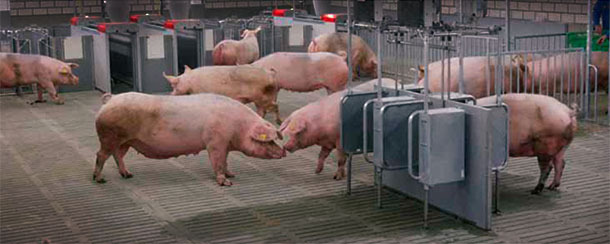In this document we present background information about NET energy system for sows. Literature and own research show that increasing fibre levels in sow diets has a positive impact on performance. Furthermore, making use of the NET energy system for sows to formulate feeds makes it possible to achieve a smooth transition from gestation to lactation diets, which makes the transition period around farrowing easier for the sows.

Sow obtain more energy from the diet than growing pigs
Feeding systems that predict the amount of energy supplied by feed have been developed in order to accurately formulate feeds for pigs. This enables a better match between feed supply and animal requirements. It reduces over (or under) supply of nutrients and, subsequently, safeguards against both feed waste and suboptimal animal performance. Feed evaluation systems for pigs are based on the supply of net energy (NE) for growth and maintenance. Originally, the NE systems were based on digestibility research on growing pigs. However, research from the last two decades has shown that digestibility of various components in raw materials differs between growing pigs and sows (Le Goff and Noblet, 2001). Sows have a lower dry matter intake relative to body size and a more developed gastrointestinal tract, which results in higher digestibility. Our feed evaluation for swine is based on conceptual equations that calculate net energy from the supply of digestible protein, fat, starch and fibre (non-starch polysaccharides NSP), partly based on CVB (2007). This conceptual approach enables the use of the same basic equation for NE calculation for both growing pigs and sows, as the main differences between growing pigs and sows is in maturity of the digestive tract.

In order to accurately calculate NE for gestating and lactating sows, we conducted research to compare digestion in growing pigs as well as gestating and lactating sows. In the research, our own data was combined with existing literature data that formed the basis for development of our own NE values for both gestating and lactating sows.
From NE pigs to NE sows
The basic premise of the work is that if the difference in digestion between sows (gestating and lactating) and growing pigs is known for various categories of raw materials, then this difference can be used to calculate sow digestibility based on growing pig data. This is beneficial, as much more research has been done with growing pigs, and this huge body of work can then be used as a basis for calculation of NE values for sows as well.
The concept of our NE systems for gestating and lactating sows is based on the differences in the digestive tract between growing pigs and sows. This influences the digestibility of the feed, increasing the digestibility of both protein and fibre (NSP). The digestive tract of sows is larger relative to their feed intake.
This leads to a lower passage rate of feed material, allowing more time for digestion and fermentation to take place. Impact on the digestion of fat and starch are not considered, since the digestibility of these components is high enough not to be influenced by the difference in feed passage rate between growing pigs and sows.



